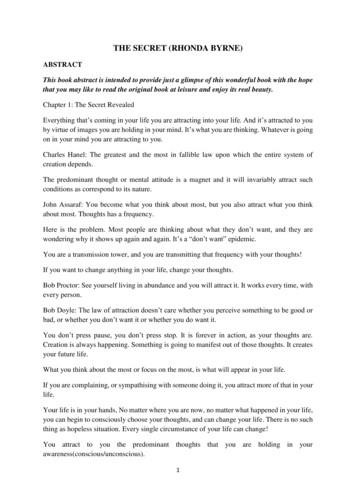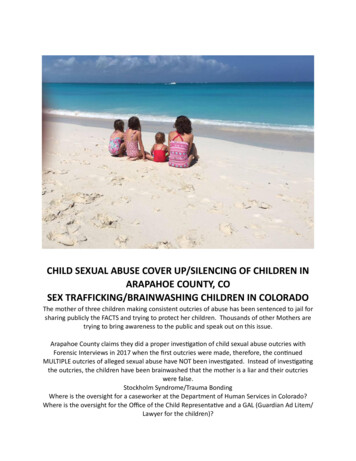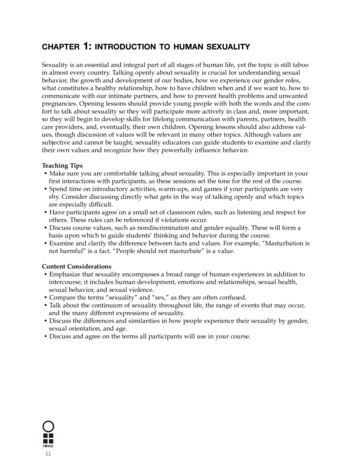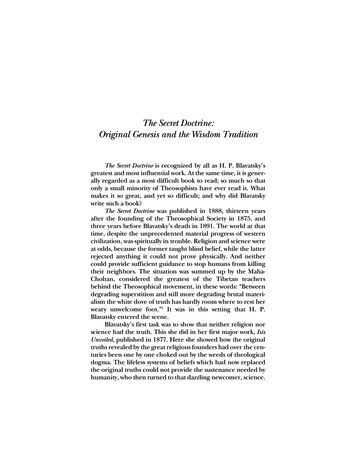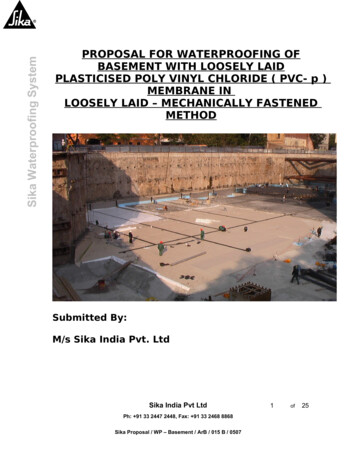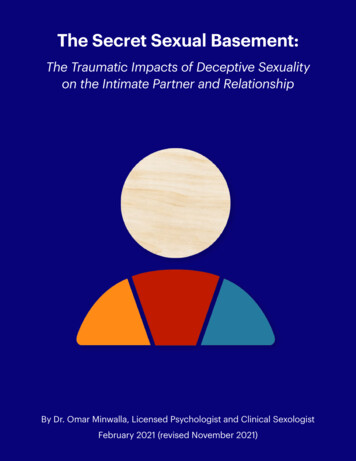
Transcription
The Secret Sexual Basement:The Traumatic Impacts of Deceptive Sexualityon the Intimate Partner and RelationshipBy Dr. Omar Minwalla, Licensed Psychologist and Clinical SexologistFebruary 2021 (revised November 2021)The Secret Sexual Basement 1
Table of ContentsNote from Dr. Minwalla 3Deceptive Sexuality 4Deceptive Sexuality Trauma (DST) 5Two Key Concepts of Deceptive Sexuality 6Three Phases of Deceptive Sexuality Trauma 7Traumatic Injuries and Symptoms of DST 8Covert Phase 9Exposure Phase 13Symptom Progression Phase 22Integrity-abuse Shaping of Intimate the Partner:Behaviors, Patterns, and Ongoing Progressive Conditions (Summary Table) 30Clinical Considerations 31Glossary of Terms 32References 33The Secret Sexual Basement 2
Note from Dr. MinwallaDear Reader:“The Secret Sexual Basement” is a metaphor to help us better understand the concept of a deceptive,compartmentalized, sexual-relational reality (DCSR) in the context of an intimate relationship(s) or family system. Itrepresents a person’s deceptively hidden sexual, romantic, and/or emotional intimacy with others that is not shared withthe primary intimate partner.This paper discusses deceptive sexuality – a specific type of abuse problem – and the trauma-related experiences andsymptoms of people impacted by it. The intent of this paper is to serve as a helpful resource for people who may beexperiencing these problems (abusers and victims), as well as for healthcare professionals who are seeking knowledgeon how to best respond to and treat clinical presentations associated with deceptive sexuality. My own learning as amental health professional has come about, in large part, through a process of sitting in rooms with victims of deceptivesexuality – with intimate partners and spouses who have been abused and traumatized in a very specific way – as anempathic witness, listening to and hearing their traumatic realities, with an open mind and heart. This paper was writtenas a synthesis of their voices – of the human beings living through and harmed by these experiences. This paper is verymuch for them – the people suffering – and was written with them in mind, and in my heart. With this type of abuse andtrauma still lying in our collective darkness, it’s my hope, particularly for victims but very much also for abusers, that thispaper may serve as a lighthouse that gives people hope and support as they attempt to survive.Reading clinical perspectives on abuse and trauma, particularly if these issues are personal, may bring about emotionaland psychological reactions that are upsetting, challenging, and sometimes overwhelming. Therefore, it is importantthat you be mindful of time, place, context, intention, and purpose as you read this paper. The content should betaken in and absorbed in a way that recognizes, appreciates, and honors your unique reactions to the material and theimpacts that the material may have on you. Importantly, the information in this paper should be read and metabolizedslowly, over time – this paper is not intended to be read in one sitting.Sincerely,Dr. Omar MinwallaAbout Dr. Minwalla and the Deceptive Sexuality and Trauma ModelDr. Omar Minwalla first studied sexual trauma among partners in 2005. He collaborated with Silvia Jason, MFT, CSAT,who articulated the initial dimensions of the partner trauma concept and highlighted the salience and prevalence ofemotional abuse and gaslighting in sex addiction-compulsivity (Jason, 2009). Using Dr. Minwalla’s initial research alongwith Silvia Jason’s initial dimension articulation, Dr. Minwalla and Silvia Jason created and conducted workshops togetherand carried out research to further develop the trauma model (Jason & Minwalla, 2008). Dr. Minwalla and the Institutefor Sexual Health (ISH) then went on to further develop the term sex addiction-induced trauma (SAIT) and the thirteendimensions of sex addiction-induced trauma among partners and spouses through direct clinical application andgrounded-theory research methodology (Minwalla, 2012a). Dr. Minwalla then continued the evolution of the model (nowknown as the Deceptive Sexuality and Trauma Model) by developing the terms “integrity abuse” and “deceptive sexuality”and by integrating these concepts, as well as domestic abuse and gender pathology, into the model.Dr. Minwalla would like to acknowledge Silvia Jason, MFT, CSAT for her early contribution to the model, the ISH clinicalstaff for the application and further development of the treatment model, and especially all the people who have sharedtheir experiences in an attempt to heal.The Secret Sexual Basement 3
Deceptive SexualityDeceptive sexuality refers to problematic sexual behaviors in combination with associated patterns of domestic andintimate partner relational abuse that frequently lead to traumatic injuries. Abuse usually includes an ongoing pattern ofbehaviors, attitudes, and beliefs in which a partner in an intimate relationship attempts to maintain power and controlover the other through the use of psychological, physical, and/or sexual coercion. Abuse usually produces fear andtrauma in those being victimized (Intimate Partner Abuse and Relationship Violence Working Group, 2001).The Deceptive Sexuality and Trauma (DST) ModelThe Deceptive Sexuality and Trauma (DST) Model expands the understanding, diagnosis, and treatment of sexualacting-out disorders beyond the scope of traditional models. It confronts the traditional and current models oftreatment and brings a critical set of new arguments to the ongoing debate related to sex addiction and compulsivesexual behavior disorder. Importantly, the model and its components are derived from both grounded qualitativeresearch and direct clinical application indeed, the model has been developed by including the victim’s perspective– from the bottom looking up, not just from the top looking down. The DST Model identifies deceptive sexuality asa form of domestic abuse and revises the clinical paradigm of sexual acting-out behaviors in at least three importantways:1. The DST Model expands the traditional, single-concept diagnosis of either sex addiction or compulsivesexual behavior to include sexual entitlement, thus deriving compulsive-entitled sexuality (CES) as a majorfactor that contributes to problematic sexual behavior patterns. CES refers to an inability or an unwillingness tocontrol sexual urges or behaviors, even when they cause significant negative consequences. Examples of CESinclude problematic patterns of pornography, infidelity, prostitution, cybersex, and flirting. Sometimes CES caninclude clinical concerns such as sexual offending, abuse of power in the workplace, etc.2. The DST Model gives attention to the roles that conduct disorder and covert psychological and relationalabuse behaviors play in sexual acting-out behaviors and considers these pathological patterns to be a type ofintegrity-abuse disorder (IAD). IAD is a type of conduct disorder that is defined by a significant lack of integrityand a covert relational abuse system. IAD is characterized by sociopathic patterns and antisocial personalitycharacteristics and behaviors such as: a long-term pattern of disregard for, or violation of, the rights of othersa demonstrated lack of empathy toward othersdeception and manipulation of the truthpsychological manipulation of others (gaslighting)exploiting others for personal gain or pleasure through superficial charm, seduction, or intimidationdeficits in conscience (Simon, 2011), integrity, and/or moralityimpulsivity and reckless behaviorsa lack of remorse; callous attitude towards people harmedcovert domination and controlThese types of behavior patterns, referred to as integrity abuse (IA), can lead to repeated harm and abusewithin relationships, particularly with intimate partners and family systems.3. The DST Model identifies intimate partners and family members of people who have engaged in deceptivesexuality, who are subjected to patterns of both CES and IA, as victims of abuse who often experiencedevastating trauma symptoms. As such, this model shines a light on the abuse-victim dynamic that so frequentlyoccurs, but is often overlooked, in these situations. The model challenges the codependency view that hasoften been associated with the single-concept diagnosis of co-sex addiction (Carnes, 1991) as well as otherperspectives that may inadvertently blame the relationship or the intimate partner (Minwalla, 2012b).The Secret Sexual Basement 4
The DST Model proposes that compulsive-entitled sexuality (CES) and integrity-abuse disorder (IAD) cause individualsto sexually act out in ways that lead to significant traumatic injuries for their victims. Importantly, the model recognizesthat in such situations, abuse problems exist in addition to sexuality issues. Further, this model replaces existing victimblaming models with abuse-trauma awareness, consciousness, and trauma-based treatment approaches (Minwalla,2011a, 2012b).Deceptive Sexuality Trauma (DST)Deceptive sexuality trauma (DST) is a psychological term that describes both the traumatic impacts and the traumasymptoms caused by the deceptive sexuality. According to this model, deceptive sexuality – and its associatedpatterns of psychological deception and manipulation – represents a specific type of abusive conduct thatcauses a specific type of trauma. And understanding the specific type of trauma that victims of deceptive sexualityexperience requires a description and basic knowledge of both post-traumatic stress disorder (PTSD) and complextrauma (C-PTSD), as victims of deceptive sexuality often experience symptoms related to both.Important Distinction: Deceptive sexuality trauma (DST) refers to the direct impacts ofpatterns and behaviors related to CES and IAD, not to developmental or childhood traumathat may have been previously experienced by the victim. This is an important distinction.Developmental or childhood trauma is not the same as DST. DST is a clinical term thatdescribes specific traumatic symptoms that result from patterns of abuse and injuriousexperiences associated with being a victim of deceptive sexuality.PTSD involves a single or distinct event or traumatic incident, which results in symptoms of intrusions, avoidance orconstrictions, and hyperarousal. Many partners and family members of individuals who have engaged in deceptivesexuality develop symptoms that meet most of the criteria for PTSD-related symptoms, including: exposure to extreme stressintrusive re-experiencingfrequent episodes of triggering and reactivity associated with hyperarousal and hypervigilancepersistent avoidancenegative alterations in both thoughts and moodSome experience: anxiety about potential disease and contaminationworries about child safetysocial isolationsignificant embarrassment and shameintense relational rupture and attachment injuriesAcute post-traumatic stress often occurs around the time that a partner finds out about the sexual acting-out behaviors,also known as the deceptive, compartmentalized, sexual-relational reality (DCSR).The Secret Sexual Basement 5
In this model, C-PTSD (Herman, 1997), or what is referred to as complex trauma shaping (CTS), involves patterns ofharm that exist over a period of time and in the context of disempowerment or the lack of a viable escape route. Theseexperiences shape a person’s psyche over time, like drops of water on a rock. CTS is a process that gradually developsin response to the long-term progressive patterns of psychological, emotional, and relational harm that are associatedwith sexual acting-out behaviors and abuse patterns. CTS can include progressive negative alterations to: emotional functioning, thoughts, self-perceptions, and esteemrelational and attachment functionsperceptions of the abuserhow the person relates to other human beings, their lives, and/or their realitiesComplex trauma may also impact a person’s survival instincts and erode their ability to depend on their second brain.This type of trauma may also negatively impact physical, sexuality, gender, relational, and social functions.Keep in Mind: Complex trauma shaping (CTS) is a term that is based on the principles andprocesses of complex trauma (Herman, 1997). However, in the Deceptive Sexuality and TraumaModel we conceptually extend and expand the description of complex trauma symptoms bydefining each symptom cluster in broader terms and by including more normative and lesssevere forms of harm.Two Key Concepts of Deceptive SexualityBefore we move forward, it is important to define and clarify two key concepts associated with deceptive sexuality:deceptive, compartmentalized, sexual-relational reality (DCSR) and pre-existing reality-ego (PRE).Deceptive, Compartmentalized, Sexual-relational Reality (DCSR). A person’s secret sexual or romantic life can bereferred to as a deceptive, compartmentalized, sexual-relational reality or DCSR for short. It represents a person’sdeceptively hidden sexual, romantic, and/or emotional intimacy with others that is not shared with the primary intimatepartner.A metaphor might be useful in helping to understand DCSR:Imagine a home where all members of a particular family reside. They live happily within the home, with its twobedrooms and two bathrooms, spanning two floors. They make dinners together in the kitchen and store theirsporting goods in the garage. But what they aren’t aware of is that this happy home includes a secret basementdown below. In reality, there exists an entire hidden basement to this home a basement full of secrets andactivities, that only one member of the family knows about.This family member created and maintains this hidden basement. He or she enters it to engage in secret sexualbehaviors and to connect and interact with other people in a sexual, romantic, and/or emotional manner. Further,when this family member goes into the basement, they become a person who the rest of the family wouldnever recognize in terms of their values, thoughts, feelings, and attitudes. This person becomes unrecognizablebecause they act in ways that are in stark contrast to how they behave and represent themselves when they arein the home with their family.We need to realize that there is a lot more in the basement besides just sexual behaviors. In fact, it’s a large spacefilled with a whole reality that is unknown to others. When we talk about a DCSR, we are not simply referring to sexualor relational behaviors or acts. We are not only describing, for example, a person’s secret use of porn, sex acts withprostitutes, or emotional connections with colleagues. A DCSR may also include interactions and conversations withother people and activities such as walking, eating, driving, spending money, and so on, and also includes the personwho built it and engages in it. Indeed, many victims and perpetrators alike describe the sexual-relational reality as livinga “double life” or being in a “separate, sexualized universe.” It is a reality.The Secret Sexual Basement 6
Pre-existing Reality-ego (PRE). The second concept that is important for us to discuss is referred to as a PRE, or theperson’s pre-existing reality-ego. The term ego here simply refers to the reality of the self, or the subjective sense of self,which is separate from the rest of reality. We all experience an internal reality, or a reality of the self, as well as a sense ofreality outside the self. The term reality-ego refers to both these realities and their interrelationship. The term pre-existingrefers to a person’s reality prior to the realization of a new reality. In the case of a DCSR, the PRE refers to everythingthat the partners and family members thought was real about their lives prior to discovering or becoming aware of theDCSR’s existence.In the metaphor of the secret basement underneath the family home, the PRE would refer to the deceived familymembers’ concept and understanding of their reality as a home without a basement. The PRE refers to everythingthat the family members thought was real about their lives prior to discovering or becoming aware of the basement’sexistence. Within the context of a DCSR, the PRE represents the partner’s and family members’ realities before theybecame aware of the DCSR.Three Phases of Deceptive Sexuality Trauma (DST)Deceptive sexuality trauma (DST) is clinically organized into three phases:Covert Phase. The covert phase of DST is defined as the phase prior to the exposure of the person’sPRE to the DCSR. It refers to the period of time during which there exists a secret sexual basement, butit remains undiscovered. This is a phase of covert domination and control as well as eroding relationalintegrity and relational health. During the covert phase, complex trauma starts to take form within itsvictims, progressively shaping emotional and cognitive systems, constructs of self and self-esteem,relations with others, and systems of meaning. There can be ongoing damage to the enteric systems orgut instincts, causing second brain injuries to those impacted.Exposure Phase. During the exposure phase, the partner’s pre-existing reality ego (PRE) collides withthe DCSR – the previous perceptions of reality are exposed to the secret sexual basement underneaththe relationship and family home. It is at this point that the discovery and awareness of the DCSR begins,and the PRE is injured and forever altered. This process represents a specific psychological injury that isreferred to as reality-ego fragmentation (REF). More specifically, the person loses their sense of realityabout the world in general, their understanding of their partner, the nature of their relationship, and theauthenticity of their attachment. It is during this phase when partners and family members begin toexperience PTSD-related symptoms.Symptom Progression Phase. The symptom progression phase of DST occurs after the exposurephase and the initial, acute PTSD-related symptoms. The symptom progression phase is defined asboth the short-term and long-term impacts and symptoms that occur in the aftermath of the covertand exposure phases that may negatively impact all aspects of the partner’s life. This phase focuses oncore wounds related to identity, sexuality, gender, attachment, and relationships as well as the postfragmentation reconstruction processes of ego, self, and reality. It may be during this phase that we startto see the net effects of the integrity abuse and the complex trauma shaping (CTS) arise and continueas the acute phase of PTSD symptoms may stabilize, recede, or decrease in intensity and/or frequency.The symptoms that are experienced in this phase may be deeper and may take longer to heal and repairthan PTSD-related trauma symptoms.Keep in Mind: The three phases of DST are not necessarily experienced by people in distinctstages or a linear order. The stages often overlap and fluctuate, and the transition between onestage and the next is frequently not a direct line of transition. Symptoms may appear in uniqueand different ways and may not precisely match the three phases as described here.The Secret Sexual Basement 7
Traumatic Injuries and Symptoms of Deceptive Sexuality Trauma (DST)Covert Phase (when the PRE and DCSR are intentionally kept separate)1. Covert Phase Integrity-abuse Shaping2. Erosion of Enteric System and Second Brain Injury3. Erosion of Relational IntegrityExposure Phase (when the PRE and DCSR intersect)4. Exposure Phase Integrity-abuse Shaping5. Discovery Trauma6. Disclosure Trauma7. Reality-ego Fragmentation8. Acute Relational Rupture and Attachment Injury9. Hypervigilance, Intrusions, and Persistent Re-experiencing10. Avoidance of Trauma-related Stimuli11. Negative Alterations in Thoughts and Mood12. Trauma-related Arousal and Reactivity13. Distress and Functional Impairment14. Dissociative SymptomsSymptom Progression Phase (the aftermath; short- and long-term impacts)15. Symptom Progression Phase Integrity-abuse Shaping16. Reality-ego Injuries and Reconstruction17. Sexual Symptoms and Functioning18. Gender Wounds and Symptoms19. Persistent Negative Relational Patterns20. Family, Communal, and Social Injuries21. Treatment-induced TraumaRemember: The traumatic experiences and symptoms described within each phase should beunderstood as occurring in an environment of ongoing psychological, emotional, and relationalabuse and harmful patterns and events - the integrity abuse (IA). It is important to remember thatnot all dimensions, impacts, injuries, and symptoms may be relevant for every partner or spouse.The SecretDr.SexualOmarBasementMinwalla 8
Covert PhaseLiving on Top of the Secret Sexual Basement without Knowing It When the pre-existing reality-ego (PRE) and thedeceptive, compartmentalized, sexual-relationalreality (DCSR) are intentionally kept separate An ongoing system of covert domination and control Involves complex trauma shaping (CTS) of the victim(s) andthe relationship Includes erosion of second brain and relational integrityThe Secret Sexual Basement 9
1. Covert Phase Integrity-abuse Shaping. Covert phase integrity-abuse shaping refers to the integrity abuse thatoccurs during the covert phase of DST. During this phase, partners often don’t realize what’s happening to them - theyare not aware that the secret sexual basement exists. This lack of information leaves them effectively disempoweredand without a viable escape route. Integrity-abuse behaviors and conditions during this phase include: lying/lying by omissiondeceptive tactics and manipulationsblaming the partner or relationshipintentional psychological manipulation of victim’s realitywithdrawal and neglectendangermentcorrosive narratives in order to justifyUnder such conditions, this phase constitutes a form of covert domination and control of a human being(s). Theongoing behaviors and conditions that take place during the covert phase cause serious psychological, emotional,and relational trauma that can lead to both short- and long-term psychological, emotional, and relational symptoms.2. Erosion of Enteric System and Second Brain Injury. During the covert phase, partners are likely to detect(consciously or subconsciously) threats in their environment; they are likely to subtly detect the presence of a secretsexual basement, even though they are not aware of it on a conscious level. However, these individuals often are notsure about where these feelings originate from. There is a fundamental incongruence between the victim’s gut instinctsand their partner’s definitions of reality. As a result, victims may experience confusion and chaos. They may struggle tounderstand what is happening to them and to make sense of their second brain signals and survival impulses.In addition, partners are often gaslighted by their abusers (Jason, 2009; Jason & Minwalla, 2009). Gaslighting (Dorpat,1994, 1996; Gass & Nichols, 1988) is the process in which the abuser intentionally manipulates their partner’s reality inorder to protect reality and the truth from becoming known or discovered by their partner (Jason, 2009). If the victimdecides to trust their partner’s definitions of reality, the victim learns (over time) to distrust and ignore their healthysurvival gut instincts. The victim loses their ability to depend on their internal system of detecting threats and propellinginstincts to survive. In addition, they may eventually become generally hypervigilant and distrusting. Sometimes victimseven become reliant on the perpetrator’s reality and use it as an adapted “survival instinct.” If the ability to utilize one’sown intuition is so compromised and abused and/or if the victim has been manipulated into deep dependency andreliance on the perpetrator’s definition and mandate of reality, then the victim may not be able to generate or act onemancipation impulses (so the idea of “just leaving” is not reality-based for some partners).The Secret Sexual Basement 10
3. Erosion of Relational Integrity. Relationship integrity refers to the honesty, truthfulness, and authenticity thateach partner brings to a relationship. Relationship integrity plays a huge role in determining how whole or complete arelationship is able to be. Relational integrity is not simply a belief in each person’s mind, but an actual reality that existsbetween two people and separate from each person’s individual evaluation or assessment of that reality. The theory ofrelational integrity proposes that integrity is part of an energetic system that exists between human beings. This theorystates that the degree of authenticity and truth expressed between two people creates an energetic system betweenthem. Within this system, each person transmits an energy that is associated with the degree of truth, authenticity,and transparency that they bring to the relationship. The energy submitted by each person, in turn, creates a type ofrelational energy between the two individuals that plays a big role in determining the integrity of the relationship. Theidea of having “a nice flow,” “good energy,” or “good vibes” in a relationship may be descriptions of this energeticsystem of openness and honesty that exists or is experienced in a relationship.Unfortunately, when there is an ongoing system of deception or lies within a relationship, the person involved tends toemit specific types of energy waves that result in an imbalanced energetic system. A deceptive, compartmentalizedsexual-relational reality (DCSR) negatively impacts a relationship’s energetic system. More specifically, a DCSRfragments the energy that exists in the relationship and creates a different frequency that is highly incongruent withthe energy of the system as a whole.Often this damage is done to the relationship specifically, and by extension to each person as well (sometimes formany years), even before the partner learns of the DCSR/secret sexual basement. The damage can include symptomssuch as: a sense of disconnectiona decreased ability to absorb intimacy or lovea weakening in the ability to depend on, or feel stabilized by, the relationshipincreased feelings of isolation and loneliness in the relationshipfewer expressions of emotional nurturancean increased likelihood for avoidance – including avoiding sexuality and physical touchincreased feelings of aversion and emptiness in the relationshipThe Secret Sexual Basement 11
The Secret Sexual Basement 12
Exposure PhaseDiscovering the Secret Sexual Basementand the Abuser’s Role in Building It When the person is exposed to the secret sexual basement Exposure occurs through discoveries and/or disclosures Involves post-traumatic stress symptoms coupled with integrity abuse Includes reality-ego fragmentation (REF) and attachment injury Can be experienced as a psychological “death”The Secret Sexual Basement 13
4. Exposure Phase Integrity-Abuse Shaping. Exposure phase integrity-abuse shaping refers to the integrity abusethat occurs in the exposure phase of DST, during which the partner’s pre-existing reality-ego (PRE) intersects with theDCSR. In this phase, the previous perceptions and structures of reality are exposed to the secret sexual basement.This process represents a specific psychological injury that is referred to as reality-ego fragmentation (REF). Duringthe exposure phase, partners often experience intense, ongoing integrity abuse in the form of continuing patterns ofemotional, psychological, and relational harm. The person who created and has been maintaining the secret basementwill often try to defend themselves and to protect the truth from being exposed by utilizing specific defenses, oftenimmediately after the initial discovery of the DCSR. The types of deceptive, manipulative, and defensive behaviors thatoccur in the exposure phase include: covering-uplying/lying by omissionpresenting partial disclosures as full disclosuresrevising facts and historyblamingobstructingstonewallingrefusing to cooperate or speaktwisting the truthgetting angry threateningbeing aggressive or passively aggressiveusing forms of domination and controlequivocatingwithdrawingfeigning innocence or ignoranceassuming the role of victimfault-findinggaslighting (psychologically manipulating)demanding immediate equalityengaging in frequent or rapid integrityviolations or abusive actionsshaping the narrativedefying logic or reason as a protective tacticusing technical manipulationExposure to this type of ongoing integrity abuse often causes victims to suffer both acute traumatic experiences andprogressive CTS.5. Discovery Trauma. Discovery of a secret sexual basement is a critical traumatic incident (discovery incident) aswell as an ongoing traumatic process (discovery trauma). The configuration of traumatic discovery experiences canvary (Steffens & Rennie, 2006). Discovery can be an initial awareness or a gradual development of consciousness, butis often a sudden and direct collision between the victim’s pre-existing reality and the secret sexual basement. Thiscollision may cause post-traumatic stress symptoms, which are often acute and progressive and can include shockand disbelief, a high degree of rage due specifically to the betrayal, extreme fear, hyper-vigilance, and trauma-basedreactivity and survival responses.The collision may also cause reality-ego fragmentation (REF), as structural and functional damage alters the victim’s preexisting reality. This destabilizing injury is threatening to the psyche and introduces fear into the psychological-relationalsystem, including “flight,” “freeze,” or “flee” survival-based responses. The victim’s pre-existing reality is altered fromits original form forever, resulting in a psychol
The Secret Sexual Basement 3 Note from Dr. Minwalla Dear Reader: “The Secret Sexual Basement” is a metaphor to help us better understand the concept of a deceptive, compartmentalized, sexual-relational reality (DCSR) in the co


